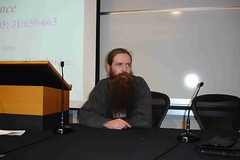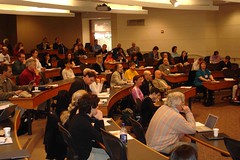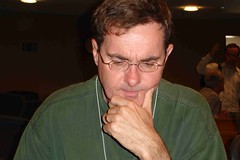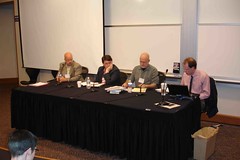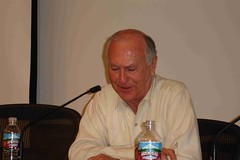 My libertarian socialist sensibilities were both tickled and agitated this week when I learned that Warren Buffett, the world’s second richest man, donated virtually his entire $31 billion fortune to the Gates Foundation. Buffett is known for his philosophical opposition to dynastic wealth, but the donation was also emblematic of his support for what is coming to be regarded as "philanthrocapitalism" – the increasing trend toward entrepreneurial approaches to philanthropy.
My libertarian socialist sensibilities were both tickled and agitated this week when I learned that Warren Buffett, the world’s second richest man, donated virtually his entire $31 billion fortune to the Gates Foundation. Buffett is known for his philosophical opposition to dynastic wealth, but the donation was also emblematic of his support for what is coming to be regarded as "philanthrocapitalism" – the increasing trend toward entrepreneurial approaches to philanthropy.This latest trend has me both delighted and concerned. I’ve always had a problem with conspicuous money hoarding, and it’s good to see some considerable coin being tabled for humanitarian needs. But at the same time I have to question both the sincerity and the motivation of the so-called philanthrocapitalists. Are they truly working in the best interests of the world’s poor? Or are they merely working to further their own causes and those of other capitalists by creating entirely new targetable consumers? Is this yet another example of how corporatism is increasingly entrenching itself in global society?
Perhaps it’s all the above. The question to ask is whether or not the outcome will truly be beneficial for all.
Most people acknowledge the problems and limitations of small scale charities. These groups are often resource strapped, idealistic, bureaucratic, and stunningly ineffective. The new supercharities, on the other hand, promise to operate in a way that more closely resembles the corporate world. Prospective donors act as potential investors, looking for high returns in terms of how the donations will benefit recipients. More and more, donations are given only after cost-benefit analyses are performed to ascertain what the gifts might actually accomplish. In this sense, charities resemble capitalist economies in which benefactors become consumers of social investment.
Further, as some are quick to point out, the costs of not investing are startlingly high—-and it’s not just the human cost but the fiscal cost as well. Bill Gates calculated that had malaria been wiped out in Africa in the 1960’s its gross domestic product would have been $100 million higher than it is today. Well funded groups like the Gates Foundation can micro-manage every dollar it commits and judge the exact impact of its interventions. What I'm left wondering is, was Gates concerned that people were dying of malaria, or that a potential GDP market of $100 million was left squandered for so long?
For those like myself with leftist tendencies, there’s significant potential for concern here. The rise of philanthrocapitalism is essentially for-profit philanthropy. While I’m sure that many of the donors who are “investing” their money in charities are truly doing so with good intentions, it is clearly not an entirely selfless act. The motivations are legitimately suspicious, and one wonders if Gates, Buffett and others are merely trying to open up new markets and new demographics.
Hold on -- now am I being all sour grapes, here? Are my concerns symptomatic of my own petit bourgeois complacency and cynicism? Do the motivations and intentions of the benefactors really matter? Sustainability issues aside, if people are healthy, fed, clothed, and sheltered, while also having jobs and things to buy, isn’t that a great and noble achievement unto itself?
Well, I suppose it’s a great achievement in a Fukuyamaesque end-of-history sort of way, but it brings to light the unsettling issue of overwhelming global (and even totalitarian-like) corporatism and the withering away of governmental accountability in this domain. Given the proliferation of philanthrocapitalism, one can imagine governments growing increasingly indifferent to spending money on aid. Why bother, after all, when the capitalists are doing such a good job? What a great opportunity to lower taxes and shrink government even further!
Unlike philanthrocorporate interests, which are self-serving and subject to cost-benefit analyses, states and their governments – which are supposedly working on behalf of the public interest – are in a special position to gauge the worthiness or urgency of certain causes and broader social interests. While the philanthrocapitalists can arbitrarily choose which humanitarian battles to wage, governments can be better persuaded (ie democratic due process) to enter into those arenas that may seem unpalatable to the capitalists but are worthy and important problems nonetheless.
I’m not opposed to supercharities. In fact, I think it’s a remarkable development in the history of philanthropy and the affairs of the obscenely rich. What I’d like to see, however, are strong governments and international bodies who will stand up to the corporatist tsunami and offer a guiding voice.
The goal, after all, is to create healthy, happy, and prosperous people – something most people agree is a good thing. The risk, however, is the demise of democratic and participatory values that are replaced by a corporatist world in which all aspects of human existence are shaped by capitalist urges.
Tags: philanthrocapitalism, charity, gates foundation, warren buffett, corporatism, capitalism, humanitarianism, philanthrophy, globalization.





